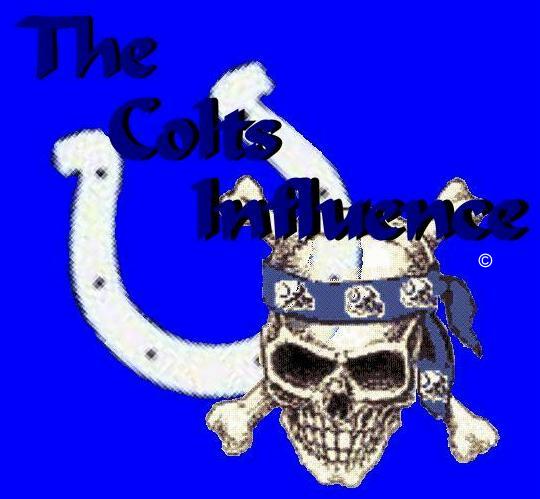|
The Colts Influence
Constructed, destructed and reconstructed
Colts
FORUM
Colts
BLOG
The Colts Influence www.mycolts.net/coltsinfluence http://myspace.com/coltsinfluence
|
History of Football
Football is the name given to a number of different, but related, team sports. The most popular of these world-wide is association football (also known as soccer). The English word "football" is also applied to American football, Australian rules football, Canadian football, Gaelic football, rugby football (rugby union and rugby league), and related games. Each of these codes (specific sets of rules) is referred to as "football" by its followers Football, an outdoor game, played by two opposing teams with a ball of various types, usually an inflated bladder or rubber bag in a leather or rubber cover, spherical or ellipsoidal in shape. The object of the game is to score points by carrying the ball across the goal line of the opponents, or by kicking the ball through or over the goal of the opponents. While it is widely believed that the word "football" (or "foot ball") originated in reference to the action of a foot kicking a ball, there is a rival explanation, which has it that football originally referred to a variety of games in medieval Europe, which were played on foot. According to one school of thought, the origin of football and all other ball games stems from ancient fertility rites. There were no Cro-Magnon sportswriters around to chronicle the Primitive League, but anthropologists, archeologists, and other ologists concerned with matters ancient have pieced together an interesting theory from pottery shards, fossilized grain, old ashes, splintered bones, dusty doohickeys, and the customs of primitive people who still exist in the world today. The ologists point out that representations of the sun are used by many primitives in magic ceremonies to fructify soil and all growing things. Often discs are hung on trees or buried in the ground. Sometimes a ball is used. These primitive men believe the success of their crops depends in some way on how they handle the symbolic sun. Many ologists reason that what is true of today's primitives was often true of people living thousands of years ago. Sometimes the ball-sun, perhaps only a round stone, was tossed back and forth in a kind of ritual. Soon tribes divided into groups or teams. The ritual began to take on the aspect of a contest with the teams competing for final possession of the sun. Victory could mean bountiful crops, healthy children, success in war, relief from hemorrhoids, and a whole raft of cosmic consequences. Often the contest was conducted east to west -- in the direction the sun moved. Not surprisingly, the ball-sun might first be sprinkled with water to insure rain. These games were usually played by peasants, as opposed to the horse-riding sports often played by aristocrats. While there is no conclusive evidence for this explanation, the word football has always implied a variety of games played on foot, not just those that involved kicking a ball. In some cases, the word football has even been applied to games which have specifically outlawed kicking the ball.
Throughout the history of mankind, the urge to kick at stones and other such objects is thought to have led to many early activities involving kicking and/or running with a ball. Football-like games predate recorded history in all parts of the world, and thus the earliest forms of football are not known.
Documented evidence of what is possibly the oldest activity resembling football can be found in a Chinese military manual written during the Han Dynasty in about the 2nd century BC. It describes a practice known as cuju, which involved kicking a leather ball through a hole in a piece of silk cloth strung between two 30 foot poles. Another Asian ball-kicking game, which may have been influenced by cuju, is kemari. This is known to have been played within the Japanese imperial court in Kyoto from about 600 AD. In kemari several people stand in a circle and kick a ball to each other, trying not to let the ball drop to the ground.
The forerunner of American football may have been a game played by the ancient Greeks, called harpaston. In this game there was no limit to the number of players. The object was to move a ball across a goal line by kicking it, throwing it, or running with it.
Classical literature contains
detailed accounts of the game, including its rougher elements, such
as ferocious tackling.
There are a number of references to traditional, ancient, and/or prehistoric ball games, played by indigenous peoples in many different parts of the world. For example, in 1586, men from a ship commanded by an English explorer named John Davis, went ashore to play a form of football with Inuit (Eskimo) people in Greenland. There are later accounts of an Inuit game played on ice, called Aqsaqtuk. Each match began with two teams facing each other in parallel lines, before attempting to kick the ball through each other team's line and then at a goal. In 1610, William Strachey of the Jamestown settlement, Virginia recorded a game played by Native Americans, called Pahsaheman. In Victoria, Australia, indigenous people played a game called Marn Grook ("ball game"). An 1878 book by Robert Brough-Smyth, The Aborigines of Victoria, quotes a man called Richard Thomas as saying, in about 1841, that he had witnessed Aboriginal people playing the game: "Mr Thomas describes how the foremost player will drop kick a ball made from the skin of a possum and how other players leap into the air in order to catch it." It is widely believed that Marn Grook had an influence on the development of Australian rules football These games and others may well go far back into antiquity and may have influenced later football games. However, the main sources of modern football codes appear to lie in western Europe, especially England. The Complete History of Football Most modern versions of football originated in England, where a form of the game was known in the 12th century. In subsequent centuries football became so popular that various English monarchs, including Edward II and Henry VI, forbade the game because it took interest away from the military sport of archery. By the middle of the 19th century, football had split into two distinct entities. Still popular today, these two sports were soccer and rugby. American football evolved from these two sports. The sport called soccer in the United States is still known as football throughout much of the world.
It's actually rather confusing. If you find
yourself at an international airport and tell someone that you love
football, they might think you mean soccer, which the rest of the
world calls football. It may be necessary to specifically say American
or Canadian
football (also a little bit different from each other) to come
to any type of understanding. Despite the manly football men who like to think soccer is a sissy sport, it is the first cousin of football. Soccer was the first of the three sports to be played. In 1823, during a game of football (soccer), a guy named William Ellis at Rugby School in Rugby, England, picked up the ball and ran with it to the goal. No account of the story mentions if he had gone insane or if the move was planned. Apparently, someone else also thought that was a great idea, so the game of rugby football was born. They made the ball oval shaped so it was easier to carry, but it would still bounce and be easily kicked. In 1871, the English Rugby Union came into being and gave everyone standard rules. Before this, teams would just decide on the rules before the game. Meanwhile, in America, the same confusion was beginning. On November 6, 1869, the first college soccer football game was played. Rugby was actually pretty popular already at the time, but Harvard had banned it in 1860 because it was considered "barbaric." After 1869, when collegians started playing soccer, the games got more and more like rugby. No one knew the rules anymore, because they changed constantly. The game wasn't just growing into something different than soccer. It was becoming different than rugby, too. Teams and fans liked it, but it was still confusing. In 1876, Walter Camp started attending Yale to study medicine and business. He played in the first Yale vs. Harvard rugby game that year. He was a smart man who had always been incredibly athletic. He is an important player in the history of football. He was instrumental in coming up with the rules for American football, which were written at the Massasoit Convention later that year. That convention paved the way for the NCAA. Walter Camp played Varsity for Yale from 1877 to 1882 (the last two years in graduate school), and he was captain of the team for three of those years. He's credited with a lot of the football rules and scoring still used today. While he didn't invent football - it came about more by evolution - he is widely credited as "the Father of Football." Camp created the quarterback position, the idea that one team should have undisputed possession of the ball at a time, strategic plays, the number of players, and other key positions. He was the first Yale football coach, and he was involved in every rulemaking convention and committee until his death in 1925.
The first professional football game in the United
States took place in 1895 in the town of Latrobe, Pennsylvania,
between a team representing Latrobe and a team from Jeannette,
Pennsylvania. In the following years many professional teams were
formed, including the Duquesnes of Pittsburgh, Pennsylvania; the
Olympics of McKeesport, Pennsylvania; the Bulldogs of Canton, Ohio;
and the team of Massillon, Ohio. Noted college players who took up
the professional game during its early years include Willie Heston
(formerly at the University of Michigan), Fritz Pollard (Brown
University), and Jim Thorpe (Carlisle Indian School).
The principal types of football played today are:
American
football; association football, or Soccer;
Canadian
football; Australian
football; Gaelic
football; and Rugby
football. Football is a game of antiquity, known to many peoples. The forerunner of American football may have been a game played by the ancient Greeks, called harpaston. In this game there was no limit to the number of players. The object was to move a ball across a goal line by kicking it, throwing it, or running with it. The Romans played a similar game, harpastum. In medieval times a form of football known as calcio flourished in Italy. Natives of Polynesia are known to have played a variety of the game with a football made of bamboo fibers, and the Inuit played a form of football with a leather ball filled with moss. Most modern versions of football, however, originated in England, where a form of the game was known in the 12th century. In subsequent centuries football became so popular that various English monarchs, including Edward II and Henry VI, forbade the game on the theory that it took interest away from the military sport of archery. Nevertheless, football grew steadily in popularity. At the beginning of the 19th century several types of the game-all permitting players to kick the ball but not carry it-were being played at various English schools, including Eton, Harrow, and Rugby. The modification of the game that permits carrying the ball was first introduced at Rugby in 1823 when one schoolboy disregarded the established rules, tucked the ball under his arm, and dashed across the goal of the opponents. Thereafter numerous football clubs sprang up in England, some playing the kicking game, others the ball-carrying game. In 1863 a number of clubs devoted to the kicking game met in London, organized the London Football Association, and adopted a code of uniform rules; this type of game was henceforth known as association football, and later soccer, a word derived from association. In 1871 a group devoted to the ball-carrying game organized the Rugby Football Union and adopted the rules then in vogue at Rugby School; that form of the game thereafter was known as rugby football. The two organizations still exist, and each exercises control over its respective game.
Football was first played in Australia about the
middle of the 19th century, based on rugby, soccer, and Gaelic
football. Australian Rules football (as it
is officially called) is a fast-paced game,
played on an oval field with teams of 18 players. The ball cannot be
thrown but can be caught; overhand catching, known as high marking,
and long kicking are the two distinctive features of the game. In the United States, a form of football using a blown-up bladder was played in the colony of Virginia in 1609. In 1820 students at the College of New Jersey (now Princeton University) participated in a soccerlike game, called ballown, in which they advanced the ball by punching it with their fists. Intercollegiate competition began on November 6, 1869, with a game between Rutgers and Princeton. The game, however, resembled soccer more than modern-day American football. Columbia, Cornell, and other eastern U.S. colleges soon after sent representative teams into intercollegiate competition. Harvard, preferring to use its own rules, abstained from this competition. In 1874 Harvard met McGill University of Montréal, Canada, in a match played under the rugbylike rules of the Canadians. The Harvard players, impressed, altered their own rules accordingly. Harvard and Yale played a football game for the first time on November 13, 1875, using Harvard's rules. The following year, representatives of Harvard, Yale, and Columbia answered an invitation from Princeton football representatives to attend a parley at Springfield, Massachusetts. The result of the convention included a new set of football rules and the formation of the Intercollegiate Football Association. Although the rugbylike rules of Harvard again prevailed, certain soccer rules were incorporated. The resulting combination of rugby and soccer became popular, and as time went on the rules were constantly changed until a new game evolved. The Intercollegiate Football Association was dissolved in 1894, and in the same year a rules committee, dominated by the Yale graduate and football pioneer Walter Chauncey Camp, was formed by the influential eastern schools. In 1905 an independent association of colleges also formed a rules committee; the two committees soon merged, and since that time American collegiate football has been governed by them. The first professional football game in the United States was played in 1895. The first professional football game in the United States took place in 1895 in the town of Latrobe, Pennsylvania, between a team representing Latrobe and a team from Jeannette, Pennsylvania. In the following years many professional teams were formed, including the Duquesnes of Pittsburgh, Pennsylvania; the Olympics of McKeesport, Pennsylvania; the Bulldogs of Canton, Ohio; and the team of Massillon, Ohio. Noted college players who took up the professional game during its early years include Willie Heston (formerly at the University of Michigan), Fritz Pollard (Brown University), and Jim Thorpe (Carlisle Indian School).
Strategically, the early NFL game was hardly distinguishable from college football of the time. There was no attempt to break away from college playbooks or rulebooks, and for several years the NFL followed the NCAA Rules Committee recommendations. In the league's early years, players considered the low-paying NFL a part-time job and held other jobs during the day. Thus, while college coaches could drill their players daily for hours, professional football coaches arranged practices in the evenings, sometimes only three or four times a week. The popularity of the professional game slowly began to equal its college rival after the NFL instituted its first player draft in 1936. As many talented college players opted to play in the NFL, the professional game also drew more fans. The Chicago Bears, the Chicago Cardinals, the Detroit Lions, the Green Bay Packers, and the New York Giants were some of the league's dominant teams during the period. Outstanding players included running back Cliff Battles, quarterback Sammy Baugh, running back Tony Canadeo, and receiver Don Hutson. The Great Depression of the 1930s and World War II (1939-1945), however, drained many of the early professional franchises of money and players. After World War II, college teams were allowed free substitution of players-that is, a player could enter and leave the game an unlimited number of times, as long as the ball was not in play during the substitution. This feature of the game led to the modern two-platoon system, in which one group of 11 players enters the game to play offense and a second group enters to play defense. The trend toward platoons crossed over to the professional game.
Although talented, the quarterbacks of the 1930s and early 1940s seldom completed more than 50 percent of their passes. A major cause of these low percentages was the primitive nature of pass-blocking strategies. With little protection, passers always had to throw while avoiding incoming rushers. Brown installed a blocking system that radically transformed the passing game. He changed the system by arranging the linemen in the form of a cup that pushed most pass-rushers to the outside and provided a safe area, called a pocket, from which the quarterback could pass. Using the strategy, Brown coached Cleveland to four AAFC championships from 1946 to 1949. In 1950 the Browns, 49ers, and Colts joined the NFL in a merger of the two leagues. The move ushered in a period of popularity and prosperity. Throughout the 1950s and early 1960s players such as quarterbacks Norm Van Brocklin, Y. A. Tittle, and Johnny Unitas; receiver Tom Fears; running back Jim Brown; defensive back Tom Landry; linebacker Ray Nitschke; and all-around standout Frank Gifford ignited the league and attracted fans. During the period a select group of franchises won NFL championships, including Cleveland (1950, 1954, 1955), Detroit (1952, 1953, 1957), and Baltimore (1958, 1959). The advent of television helped to popularize the professional game when in 1956 the Columbia Broadcasting System (CBS) began to broadcast select games.
This website is an unofficial source of news and information continually updated from thousands of sources around the net. A fan based site dedicated to the Indianapolis Colts and its fans and is not associated with the Indianapolis Colts, the National Football League, any school, team or league or any other media site. This website is the composition of many hours of research. Information contained within this site has come from numerous sources such as websites, newspapers, books, and magazines. Please take the time to visit the Source page to get a semi-complete listing of these sources, articles, sites and fans.
Pictures and logos, team names are property of
the National Football League and/or The Indianpolis Colts.
Please direct website comments
|
|||




